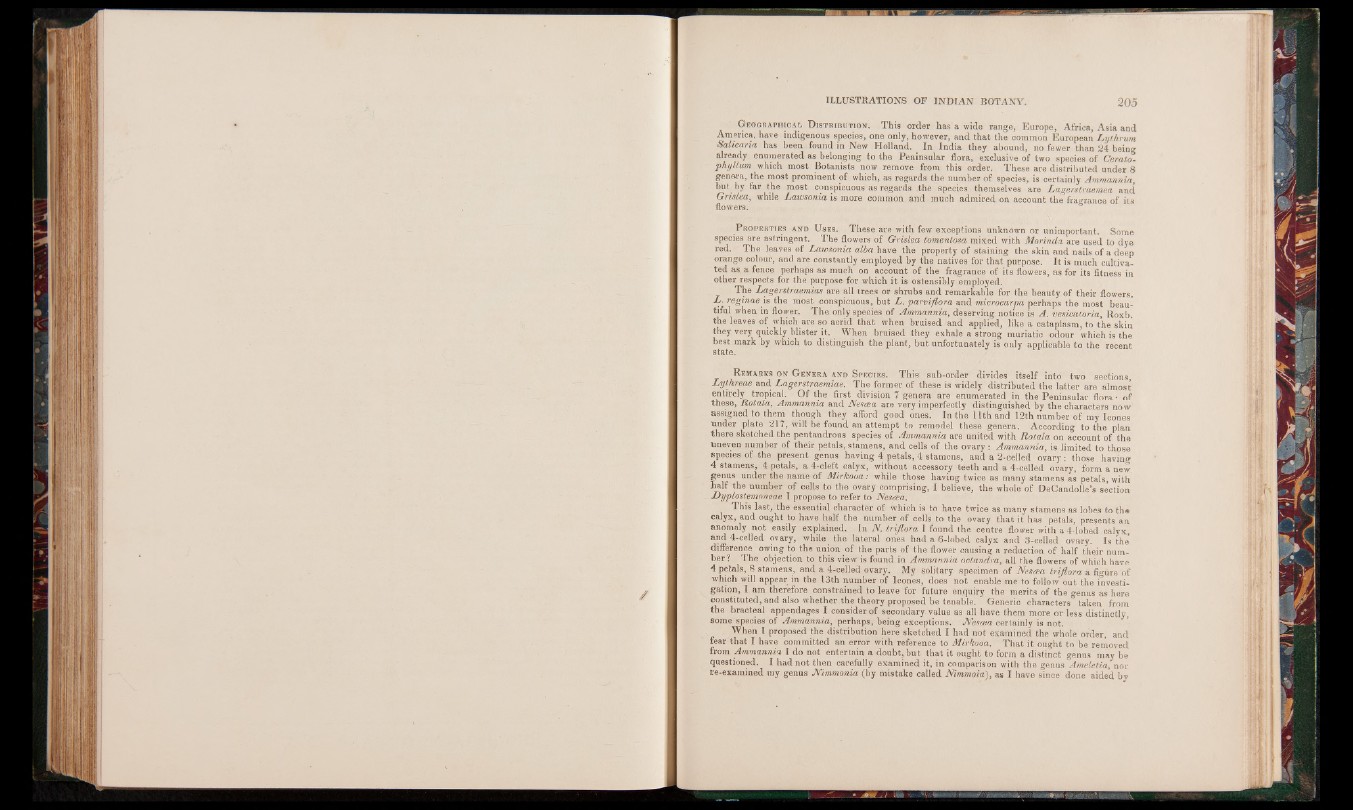
G eographical D istr ibu t ion. This order has a wide range, Europe, Africa, Asia and
America, have indigenous species, one only, however, and that the common European L y lh r um
Salicaria has been found in New Holland. In India they abound, no fewer than 24 being
already enumerated as belonging to the Peninsular flora, exclusive of two species of Cerato-
p h y llum which most Botanists now remove from this order. These are distributed under 8
genera, the most prominent of which, as regards the number of species, is certainly Am m a n n ia ,
but by far the most conspicuous as regards the species themselves are Lagerstraemea and
Grislea, while L aw so n ia is more common and much admired on account the fragrance of its
flowers.
P rop erties and Us e s . These are with few exceptions unknown or unimportant. Some
species are astringent. The flowers of Grislea tomentosa mixed with M orinda are used to dye
red. The leaves of L awsonia alba have the property of staining the skin and nails of a deep
orange colour, and are constantly employed by the natives for that purpose. It is much cultiva.
ted as a fence perhaps as much on account of the fragrance of its flowers, as for its fitness in
other respects for the purpose for which it is ostensibly employed.
The Lagerstraemias are all trees or shrubs and remarkable for the beauty of their flowers.
L . reginae is the most conspicuous, but L . parviflora and microcarpa perhaps the most beautiful
when in flower. The only species of Am m a n n ia , deserving notice is A . vesicatoria, Roxb.
the leaves of which are so acrid that when bruised and applied, like a cataplasm, to the skin
they very quickly blister it. When bruised they exhale a strong muriatic odour which is the
best mark by which to distinguish the plant, but unfortunately is only applicable to the recent
state.
R emarks on G enera and S pec ie s . This sub-order divides itself into two sections,
L y tk r e a e and Lagerstraemiae. The former of these is widely distributed the latter are almost
entirely tropical. Of the first division 7 genera are enumerated in the Peninsular flora : of
these, R o ta la , Am m a n n ia and Nescea are very imperfectly distinguished by the characters now-
assigned to them though they afford good ones. In the 11th and 12th number of my leones
under plate 217, will be found an attempt to remodel these genera. According to the plan
there sketched the pentandroas species of Am m a n n ia are united with R o ta la on account of the
uneven number of their petals, stamens, and cells of the ovary: Am m a n n ia , is limited to those
species of the present genus having 4 petals,.4 stamens, and a 2-celled ovary: those having
4 stamens, 4 petals, a 4-cleft calyx, without accessory teeth and a 4-celled ovary, form a new
genus under the name of M irko o a : while those having twice as many stamens as petals, with
half the number of cells to the ovary comprising, I believe, the whole of DeCandolle’s section
Dypldstemoiieae I propose to refer to Nescea.
This last, the essential character of which is to have twice as many stamens as lobes to the
calyx, and ought to have half the number of cells to the ovary that it has petals, presents an
anomaly not easily explained. In N . triflo ra I foupd the centre flower with a 4-lobed calyx
and 4-celled ovary, while the lateral ones had a 6-lobed calyx and 3-eelled ovary. Is the’
difference owing to the union of the parts of the flower causing a reduction of half their number
? The objection to this view is found in Am m a n n ia octandra, all the flowers of which have
4 petals, 8 stamens, and a 4-celled ovary. My solitary specimen of Nescea triflo ra a figure of
which will appear in the 13th number of leones, does not enable me to follow out the investigation,
I am therefore constrained to leave for future enquiry the merits of the genus as here
constituted, and also whether the theory proposed be tenable. Generic characters taken from
the bracteal appendages I consider of secondary value as all have them more or less distinctly,
some species of Ammannia, perhaps, being exceptions. Nescea certainly is not.
When l proposed the distribution here sketched I had not examined the whole order, and
fear that I have committed an error with reference to Mirkooa. That it ought to be removed
from Am m a n n ia I do not entertain a doubt, but that it ought to form a distinct genus may be
questioned. I had not then carefully examined it, in comparison with the genus Ameletia, nor
re-examined my genus N im m o n ia (by mistake called Nimmoia), as I have since done aided by